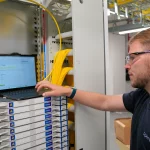Broadband Connection Vouchers Tweaked to Help Firms with Multiple Premises
The Government’s Connection Voucher scheme, which offers grants worth up to £3,000 to help SME businesses install a superfast broadband (30Mbps+) service in any of 22 cities across the United Kingdom (note: many more cities will soon be added), has received another small but notable tweak in an effort to make it more attractive.
Previously the vouchers could only be used to upgrade one business property’s connection, but now businesses with more than one trading location can upgrade them all. Sadly related firms are still restricted by the £3,000 cap, which remains a hindrance. So far today’s adjustment has only been publicised for Portsmouth, Fareham, Gosport and Havant, although other areas will surely take a similar approach.
Advertisement
The voucher scheme itself, which is suffering from low uptake and was originally due to end in March 2015, has recently been extended to run until March 2016 and more cities will be added by April 2015 (here). On top of that an additional £40m was also added to the pot (total of around £140m).
Meanwhile many continue to argue that the money might have been better spent on helping to upgrade the most remote rural areas, but in fairness urban locations can also suffer from serious connectivity problems (the London example). Criticism will no doubt continue to be directed towards BT for its apparent slowness to resolve such issues, although in the meantime they’re happy to spend big on mobile operators and TV sport.
Mark is a professional technology writer, IT consultant and computer engineer from Dorset (England), he also founded ISPreview in 1999 and enjoys analysing the latest telecoms and broadband developments. Find me on X (Twitter), Mastodon, Facebook, BlueSky, Threads.net and Linkedin.
« UPDATE Superfast Broadband Delivery UK Project Starts TV Advertising

















































Comments are closed